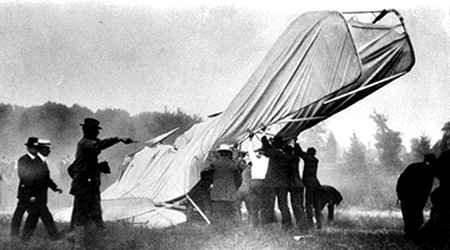Never before had someone sustained flight without the help of balloons. The historic flight did not interest reporters, who did not see the future of the technology. They saw the Wright Flyer as a barely working one-off. But Orville and Wilbur kept innovating in the face of adversity. They improved on the original aircraft by building the Wright Flyer II and III, the latter of which flew over 20 miles in 30 minutes.
The brothers then sought to commercialize their design as an observation platform for the Army. The US Army, however, were uninterested in the design, seeing it as impractical and unsafe. The brothers then took their invention to France, hoping to sell some to the French Army. The demonstration flights were extreme successes, drawing thousands of spectators. During their time in France, the brothers gave rides to journalists, statesmen, and officers. The kings of Great Britain, Italy, and Spain came to see the flights. Upon return to the US, the brothers were approached by the US Army for a contract for an observation plane. During demonstrations at Fort Myer, in the fall of 1908, Lieutenant Thomas Selfridge became the first casualty of air travel when a propeller shattered and sent the Flyer into a spin, causing fatal injuries to the Lieutenant and breaking Orville's leg.
After the crash, Wilbur went on another tour in France, leaving Orville in the US to recover from his injuries. The tour attracted interest from the French and Italian armies, and Wilbur secured a few contracts for pilot training and aircraft. Upon returning to the US, the brothers were invited to meet President Taft, who gave them multiple awards for their commitment to flight. After celebrations, they made a 30-minute flight around New York, flying up and down the Hudson River and around the Statue of Liberty, showing the reliability of their machine and cementing their place in history.



2 comments:
With the invention of air travel, a new market opened up for investors. This meant that there would be the opportunity for monopolies. Luckily thanks to the Sherman Antitrust Act in 1890, the aerospace market would never be monopolized, making the aerospace market one of, if not, the first the market in the US to be significantly influential towards the world and have been an equal opportunity market.
I think that you did a great job of integrating images into the text! As you discussed, the brothers' invention was able to grab the attention of several countries, leading the US Army to form a contract with them. The Army's contract was approved by President Taft, with the price of the aircraft at $25,000. This price was formed, with various conditions in mind, such as the ability to carry a passenger, alongside the pilot, at an average speed of 40 mph for at least an hour-long flight. The plane created specifically for this flight exceeded the requirements, and was consequently bought for $30,000. Today, $30,000 is approximately $831,250. This steep price demonstrates how impressive this invention was, especially for the limited technology at the time.
Post a Comment